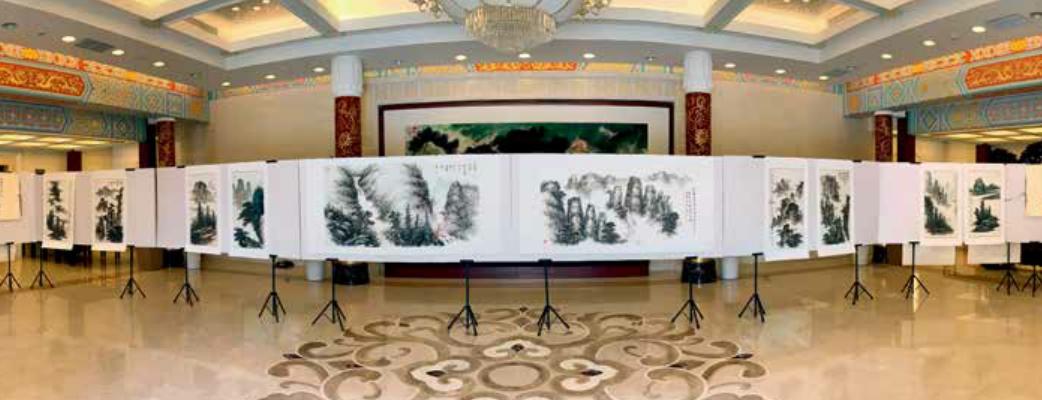Zhou Hongru Painting a Way Home
2019-06-04byYuGe
by Yu Ge

In 1989 when he first visited the Grand Canyon in Arizona, Zhou Hongru had been living in the United States for four years. The rigid rocks and rivers stunned him, inspiring him to paint the impressive landscape with traditional Chinese painting skills.
Over the following decade, Zhou visited the Grand Canyon six times before he finally finished the painting scroll Landscapes of the Grand Canyon, which has become his most famous work.
On April 13, 2019, Zhous solo exhibition “Landscape Values”opened at the Western Returned Scholars Association in Beijing, displaying the works he produced in recent years such as Landscape Values, Trees Dressed in Hues, Sanqing Mountains and August but Mild as well as a copy of Landscapes of the Grand Canyon. These works not only present the artists superb skill in traditional Chinese painting but also showcase the interaction and integration of Chinese and Western cultures.
Nearly 100 guests attended the opening ceremony of the exhibition, many of whom knew Zhou for many years and sang high praise of his creation. When the host introduced Zhous works, he noted that this year marks the 70th anniversary of the founding of the Peoples Republic of China. Zhous Chinese ink works, focusing landscapes, are the best gifts for the country. He added that the frequent “travels” of this kind of works can promote exchange between Chinese and foreign art ideas and help more people understand and fall in love with traditional Chinese culture. Chinese art critic Yang Zhaohui declared that Zhou spent 10 years painting Landscapes of the Grand Canyon in the United States, which won him high acclaim both at home and abroad. But upon returning to China, well into his sixties, Zhou has not stopped creating, which contributes more touching landscape paintings to the exhibition. Runyin Public Fund with China Social Welfare Foundation provided great support for the show.
Zhou was one of the most famous Chinese artists who ventured to the United States in the 1980s. At a young age, he learned traditional Chinese flower-and-bird painting from Wang Yuyi and Wang Xuetao, two Chinese masters, and also got guidance from landscape painting masters Qin Zhongwen and Xie Shini. In 1985, he planned a solo exhibition in the United States and ended up staying in the country. In the 30 years he lived there, he had the chance to closely examine the differences between Chinese and Western cultures, allowing him to embed contemporary art consciousness and cultural combination into his traditional Chinese painting.

It was not easy to fit in, considering that he lived in another country. In past decades, Zhou always felt an inner drive like he had a mission to finish, which propelled him to continue wielding the brush. In particular, he prepared six years to paint the scroll Landscapes of the Grand Canyon. “During that period, I started the painting many times but threw it out because the process was not smooth,” he revealed. “I tore up the paper again and again.”Over the subsequent four years and after much deliberation, he finally finished the work. “In those days,I often started working at 3 a.m. and stopped at 9 p.m., avoiding any interruptions.”
During his fourth visit to the Grand Canyon, a gust blew his canvas away. He ran after it so hastily that he fell off a cliff and passed out. After he regained consciousness, he could barely move but managed to slowly climb back up. For a long time, he dared not recount the accident to his family. An American veteran guarding the canyon examined Zhous painting for a long time. He was astonished to see many familiar landscapes in Zhous work. In addition to physical mountains and rivers, Zhou also injected his understanding and philosophy about life into this work. He intentionally painted three ancient castles of different styles on the scroll, symbolizing three phases of life: growth, success and fulfillment. The preface of the painting reveals that the three castles stand for three periods of secular life. Zhou hoped they would inject symbolism and vitality into the painting. Focusing on foreign landscapes, the scroll mainly used traditional Chinese painting style but was not confined by it. Nature guided the brush and the magnificent landscape provided inspiration. Zhou endeavored to provide Western audiences a window into Chinese culture through the work.

Alongside landscape paintings, Zhou is also an expert at drawing animals. He is a sharp observer of daily life. Dragons and horses from his brush are modest but unique, dubbed “flying dragon” and“iron-bone horse” by critics. Just a few years after he arrived in the United States, his work Lion was selected to be displayed at the White House. Also, he held exhibitions in many places across the United States like Harvard University, having won many acclaims.
Shortly after arriving in the United States, Zhou painted a dozen lifelike shrimp in several casual sketches for an event organized by the local Chinese community. Complementing the painting was a poem, translated literally as“Despite the shrimp stuck in muddy water today, ambitious goals and great competence will ensure that when the time is right, they will fly into the sky and become dragons.”This poem and painting gained him a prestige in local Chinese community and also reflected the spirit of Zhous life. Zhou has always kept the words of one French philosopher in mind: Life is like an old man carrying a parcel who keeps climbing mountains one after another, full of ups and downs. Like him, from foreign land to home, Zhou keeps walking and painting.
